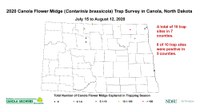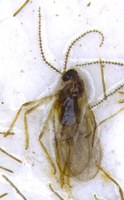NDSU Extension Survey Detects Potential Canola Insect Pest in N.D.
(Click an image below to view a high-resolution image that can be downloaded)
An NDSU Extension trap survey detected a new insect called the canola flower midge (Contarinia brassicola) in canola fields in northern North Dakota during 2020, says Janet Knodel, North Dakota State University Extension entomologist.
The canola flower midge belongs to the family Cecidomyiidae (gall midges) in the order Diptera (flies).
The canola flower midge recently was identified and found to be widespread in Saskatchewan and Alberta, Canada.
“We obtained 10 pheromone lures from Canada to monitor for canola flower midge for the first time in 2020, mainly along the northern tier of North Dakota,” Knodel says.
“At the end of the trapping, six of the 10 traps sites were positive for canola flower midge in five counties: Bottineau, Cavalier, Pembina, Towner and Walsh. The Langdon Research Extension Center in Cavalier County had the highest number of canola flower midge trapped, with a total of 344 midges captured in 2020,” Knodel says.
The adult canola flower midge is a small (less than 2 millimeters long), nondescript brown fly.
“Farmers and scouts are not likely to notice them in the field due to their cryptic color and small size,” Knodel says.
The immature stage is a small, white maggot like larva. Larvae feed and injure the flower buds by causing a swelling (or gall) that prevents flowers from opening. Damaged flowers do not produce pods or seeds. Damaged flower buds are elongated and bottle-shaped, and form a closed flower gall.
“Canadian entomologists do not know the economic impact of this new Contarinia midge in canola,” Knodel says. “There is little known about its pest management.
“Canadian entomologists observed that early planted canola (mid-May) had more midge-damaged pods compared with late-planted canola (early June),” she adds. “Insecticide seed treatments were tested for control of the canola flower midge, but no negative impact on midge injury to pods was found. This is not surprising because the adult midge emerges about four to six weeks after seeding, whereas insecticidal seed treatment activity wanes about three to four weeks after seeding.
“Future trapping and field scouting will be essential for early detection and population monitoring of canola flower midge in canola grown in North Dakota,” Knodel says. “This will help the canola industry, so we will know when these midges are present at high populations and pose a threat to canola production in North Dakota.”
The Northern Canola Growers Association and the U.S. Department of Agriculture’s Crop Protection and Pest Management - Extension Implementation Program supports the survey.
NDSU Agriculture Communication – Feb. 17, 2021
Source: Janet Knodel, 701-231-7195, janet.knodel@ndsu.edu
Editor: Kelli Anderson, 701-231-6136, kelli.c.anderson@ndsu.edu



